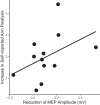Imagined paralysis reduces motor cortex excitability
- PMID: 35393640
- PMCID: PMC9539708
- DOI: 10.1111/psyp.14069
Imagined paralysis reduces motor cortex excitability
Abstract
Mental imagery is a powerful capability that engages similar neurophysiological processes that underlie real sensory and motor experiences. Previous studies show that motor cortical excitability can increase during mental imagery of actions. In this study, we focused on possible inhibitory effects of mental imagery on motor functions. We assessed whether imagined arm paralysis modulates motor cortical excitability in healthy participants, as measured by motor evoked potentials (MEPs) of the hand induced by near-threshold transcranial magnetic stimulation (TMS) over the primary motor cortex hand area. We found lower MEP amplitudes during imagined arm paralysis when compared to imagined leg paralysis or baseline stimulation without paralysis imagery. These results show that purely imagined bodily constraints can selectively inhibit basic motor corticospinal functions. The results are discussed in the context of motoric embodiment/disembodiment.
Keywords: MEP amplitude; TMS; cortical excitability; mental imagery; motor evoked potential (MEP); paralysis.
© 2022 The Authors. Psychophysiology published by Wiley Periodicals LLC on behalf of Society for Psychophysiological Research.
Conflict of interest statement
We have no conflicts of interest to declare.
Figures




